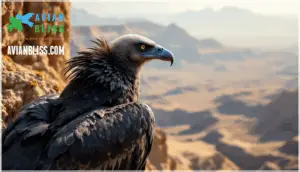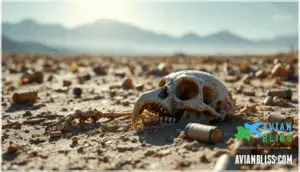This site is supported by our readers. We may earn a commission, at no cost to you, if you purchase through links.
 A California condor drifts effortlessly overhead, its wings outstretched wider than the length of your couch, casting a shadow that startles the ground below. Once nearly erased from the wild, this giant vulture now glides across sun-baked cliffs and forested canyons, a living emblem of survival against formidable odds.
A California condor drifts effortlessly overhead, its wings outstretched wider than the length of your couch, casting a shadow that startles the ground below. Once nearly erased from the wild, this giant vulture now glides across sun-baked cliffs and forested canyons, a living emblem of survival against formidable odds.
Every aspect of the condor, from its weathered plumage to its watchful stare, tells a story stitched together by ancient wilderness and modern-day rescue. Understanding its journey reveals more than endangered status—it connects you to a vast, unfolding narrative of resilience and the delicate art of keeping wild places alive.
Table Of Contents
- Key Takeaways
- California Condor Overview
- Behavior, Diet, and Social Structure
- Threats Facing California Condors
- Conservation Efforts and Recovery Programs
- How to Support Condor Conservation
- Frequently Asked Questions (FAQs)
- Are California condors aggressive?
- Why did the California condor almost go extinct?
- Is a California condor bigger than a bald eagle?
- Is the California condor a vulture?
- How big are California Condor eggs?
- How long do California Condor chicks stay with their parents?
- What is the current total population of California Condors?
- How far can California Condors fly in a day?
- What is the lifespan of a California Condor?
- How long do California condors live in the wild?
- Conclusion
Key Takeaways
- California condors have made a dramatic comeback from the brink of extinction, but their survival still hinges on intensive conservation work.
- Lead poisoning from spent ammunition remains the greatest single threat, causing high mortality and challenging population recovery efforts.
- These birds are uniquely adapted for soaring over vast landscapes, relying on their massive wings, keen eyesight, and specialized flight techniques.
- The success of condor conservation depends on habitat protection, community involvement, and ongoing advocacy to reduce human-caused risks.
California Condor Overview
The California condor stands as one of North America’s most notable birds, combining impressive size with a fascinating story of survival.
Before you can appreciate the conservation challenges these birds face, you need to understand what makes them unique. Let’s start with the basics: their appearance, where they live, and the special traits that help them thrive in the wild.
Physical Characteristics and Identification
When you spot a California condor gliding overhead, you’ll notice a bird that’s built like no other—massive, bare-headed, and unmistakably prehistoric in appearance.
These New World vultures from the Cathartidae family can reach wingspans of 9.5 feet and weigh up to 25 pounds. Their mostly black plumage features distinctive white triangular markings beneath each wing, while feather structure at the wingtips creates a finger-like appearance. Size dimorphism exists, with males slightly larger than females.
Natural Habitat and Range
You’ll find California condors across rocky shrublands, coniferous forests, and oak savannas in central and southern California, northern Arizona, southern Utah, and northern Baja California. Habitat fragmentation has reduced their historic distribution dramatically—condors once ranged from British Columbia to the American Southwest. Today’s condor population uses roughly 250,000 acres of designated critical habitat across National Forest lands.
Key features include:
- Remote cliffsides and rocky outcrops for nesting at elevations from sea level to 9,000 feet
- Large trees and snags serving as multi-year roosting sites
- Open terrain with thermal updrafts supporting daily foraging trips up to 160 miles
- Protected sanctuaries like Sisquoc and Sespe within Los Padres National Forest
Ranging behavior varies by age—subadults cover areas averaging 6,339 km², while adults maintain smaller territories. The condors’ wingspan can reach approximately 9.5 feet.
Habitat restoration and future expansion efforts aim to reconnect separated flocks across thousands of square miles of suitable but currently unoccupied North America habitat, supporting habitat preservation goals and long-term condor population recovery.
Unique Adaptations and Features
California condors don’t just survive in harsh environments—they’ve evolved striking features that make them perfectly suited for scavenging across hundreds of miles of rugged terrain. Their bald head prevents bacteria buildup when feeding inside carcasses, while specialized feather digits at wingtips improve soaring efficiency. These gliding birds use thermoregulation through exposed skin that shifts color with mood and temperature.
| Adaptation | Function | Benefit |
|---|---|---|
| Bald head and neck | Prevents feather contamination | Cleaner feeding on carrion |
| Feather digits (wing-tip extensions) | Reduce drag and increase lift | Energy-efficient soaring |
| Keen eyesight | Carcass detection from high altitudes | Locate food across vast distances |
| Skin color changes | Thermoregulation and communication | Temperature control and social signaling |
Gymnogyps californianus shares traits with other vultures but excels at covering territory—these bird nesting specialists can glide for hours without flapping, scanning open landscapes for their next meal.
Behavior, Diet, and Social Structure
California condors aren’t just impressive fliers—they’re also surprisingly complex in how they find food, conserve energy, and interact with each other. Understanding their daily behaviors reveals why these birds have survived for thousands of years and what makes them so challenging to protect today.
Let’s look at three key aspects of condor life that shape their survival in the wild.
Foraging and Feeding Habits
As scavengers, condors don’t hunt for their meals—they’re nature’s cleanup crew, patrolling vast stretches of wilderness from thousands of feet up to spot the carcasses of deer, cattle, and other large animals that have already died. Their keen vision helps with carrion detection across miles of habitat and ecology.
Once they locate food, dietary adaptations like their bald heads prevent meat from sticking during feeding. You’ll often see scavenging competition among vultures at carcasses, where feeding efficiency depends on food availability and ecological balance.
Energy Conservation and Flight Patterns
When you watch a condor glide effortlessly across the sky for hours without a single wingbeat, you’re witnessing one of nature’s most impressive examples of energy efficiency in action. These gliding birds master soaring efficiency through thermal usage, riding warm air currents that lift them to altitudes of 15,000 feet. Their flight speed can exceed 55 miles per hour using these techniques:
- Wings held horizontally in steady, unwavering position
- Thermal updrafts carrying them upward without effort
- Extended wingtip feathers improving altitude control
- Gliding techniques sustained for several hours
- Minimal flapping conserving precious energy reserves
Gymnogyps californianus exemplifies vultures’ striking adaptations, making bird tracking essential for understanding California condor movement patterns.
Social Interactions and Hierarchy
Beyond their mastery of flight, condors reveal a surprisingly complex social world marked by intelligence, playfulness, and distinct pecking orders within their groups. Dominance displays at feeding sites show larger birds claiming priority access to carcasses.
Juvenile behavior often includes play—young condors wrestle and chase each other, learning social hierarchies through these interactions.
Group dynamics promote social learning, helping California condor (Gymnogyps californianus) populations maintain behaviors essential for wildlife ecology and condor conservation status improvement.
Threats Facing California Condors
Despite decades of recovery work, California condors still face serious threats that can undo conservation progress. Lead poisoning remains the biggest killer, but it’s not the only challenge these birds encounter.
Understanding what puts condors at risk helps explain why their recovery requires constant vigilance and ongoing protection efforts.
Lead Poisoning and Its Impact
Lead poisoning stands as the single greatest obstacle to condor conservation and population recovery. Between 1992 and 2021, 120 California condors died directly from lead toxicosis, with annual exposure rates reaching 50% to 88% of free-flying birds.
Lead poisoning remains the gravest threat to California condor survival, claiming lives and endangering most of the wild population
Spent lead ammunition is the primary source—fragments from hunter-killed carcasses accumulate in condor digestive systems, causing acute health effects and requiring emergency chelation therapy.
Without intensive mitigation responses, including nonlead ammunition adoption and targeted monitoring, this endangered species faces continued mortality that outpaces natural reproduction. Conservation efforts are in place to protect the species.
Environmental Pollutants and Habitat Loss
Did you know coastal contamination exposes condors to over thirty pollutants—seven times more DDT-related chemicals than inland birds? Rodenticide exposure and microplastic impact add to the burden.
Habitat fragmentation limits nesting and foraging, while legacy pollutants like PCBs threaten reproductive success.
Environmental protection and habitat preservation strategies are essential for reducing environmental impact on condors, alongside nonlead ammunition use.
Human Disturbance and Other Risks
Imagine trying to raise a family in a place where hikers, vehicles, and noise constantly interrupt your peace—California condors face this challenge every day in the wild.
Power Line Collisions, Wind Turbines, and Vandalism add to the risks, while Microplastic Ingestion, Lead Poisoning, and shifting patterns from Climate Change intensify dangers for this Endangered Species.
Your role in Wildlife Conservation matters.
Disease and Natural Mortality Factors
Even with the best plans in place, no one can keep every threat at bay—disease and natural causes still cast a long shadow over California condors. Avian Pox, West Nile, and Aspergillosis threaten fragile populations, while limited genetic diversity and predation risks add pressure.
Wildlife rehabilitation aids Animal Welfare, but Condor Conservation remains a race against time for this Endangered Species.
Conservation Efforts and Recovery Programs
Protecting California condors takes a mix of strategy, grit, and teamwork. Over the years, people have tried different approaches to help these birds recover.
Here’s a look at the main efforts that have shaped their story so far.
Captive Breeding and Reintroduction
Through strong captive infrastructure, California Condor recovery relies on species reintroduction programs that emphasize genetic diversity and careful release strategies. Captive breeding has prevented extinction, and post-release monitoring—using GPS tracking and health checks—guarantees adaptation and survival.
Population modeling guides ongoing reinforcement, showing that continued releases are essential for species recovery and the long-term success of wild condor populations.
Habitat Protection and Restoration
You play a key role in habitat protection by supporting land acquisition and reforestation efforts, which help restore ecological balance and create climate resilience.
Habitat corridors allow condors to travel safely between nesting and feeding areas.
By backing habitat preservation strategies and ecological restoration, you strengthen bird habitat preservation and keep species reintroduction programs successful for future generations.
Lead Reduction Strategies
As you support habitat restoration, you’ll notice condor recovery hinges on tackling lead poisoning. Ammunition bans and source reduction programs help, but ongoing challenges persist. Here’s how progress unfolds:
- Lead Monitoring: Frequent blood tests flag exposure.
- Nonlead Ammunition: Free exchanges encourage safer hunting.
- Community Engagement: Outreach grows adoption, yet supply and compliance hurdles remain for endangered species conservation.
Education and Community Engagement
Through Community Awareness and Educational Programs, you help build Condor Advocacy and inspire Youth Engagement. Public Involvement—like attending talks or sharing sightings—strengthens Conservation Efforts.
When you encourage Community Involvement in Conservation, you support Wildlife Conservation and Endangered Species Protection.
Every step, from local events to classroom lessons, fuels Environmental Conservation and keeps California condors soaring.
How to Support Condor Conservation
If you’re interested in helping California condors, there are a few practical ways to get involved. You don’t need to be a scientist or work in wildlife to make a difference. Here are some options you can consider.
Reporting Sightings and Citizen Science
Have you ever wondered how a quick glance at a soaring condor could help shape the fate of an entire species? When you report sightings, you’re joining a network of citizen science and community involvement in conservation. Accuracy matters—your observations feed into Sighting Protocols and Data Contribution, strengthening Wildlife Conservation. Each report helps experts track condor movements, monitor impact, and improve Conservation Efforts. Bird Conservation thrives when citizen engagement is high.
Consider these ways your input matters:
- Recording locations
- Noting behaviors
- Photographing individuals
- Sharing with researchers
- Following Sighting Protocols
Volunteering and Supporting Organizations
Rolling up your sleeves to volunteer with condor conservation groups offers a hands-on way to make a real difference for these extraordinary birds. Volunteer opportunities span everything from wildlife rehabilitation efforts and educational outreach to supporting advocacy efforts and organizing public events.
Even if fieldwork isn’t your style, donation impacts are profound, helping conservation efforts and management teams take on critical projects.
California Condor conservation depends on strong partnerships—whether it’s nonprofit organizations, engaged communities, or corporate partnerships willing to champion wildlife conservation efforts together.
Frequently Asked Questions (FAQs)
Are California condors aggressive?
Curiously, strength and patience often go hand in hand. In fact, condor dominance shows up in subtle ways—displays, postures, or defensive behavior—especially around scavenging competition.
True aggression among wild condors is rare outside brief, juvenile disputes or direct human interaction.
Why did the California condor almost go extinct?
Lead poisoning from spent ammunition, DDT impacts, habitat destruction, poaching threats, and slow reproduction all drove the condor population toward extinction.
These threats to condor populations highlight why condor conservation and switching to nonlead ammunition remain urgent for this endangered species.
Is a California condor bigger than a bald eagle?
Size comparison isn’t even close—one look settles it. The California condor, with a wingspan over 9 feet and weighing up to 25 pounds, easily outclasses the bald eagle in both wingspan differences and weight analysis.
Is the California condor a vulture?
Yes, California Condors belong to the vulture classification, specifically the New World vultures, known as Cathartiformes. Their condor ancestry highlights convergent evolution, showing similar ecological roles to Old World vultures despite distinct bird species lineages.
How big are California Condor eggs?
Egg size factors like eggshell composition, clutch size, and incubation period all play a role—most eggs measure about 4 to 5 inches long, with sturdy shells supporting hatching success in this endangered bird species’ nesting and recovery efforts.
How long do California Condor chicks stay with their parents?
Chick dependency lasts about a year. During this period, post-fledging care is critical as parental roles shift to teaching survival skills.
The independence schedule confirms each young bird’s progress, aiding condor conservation efforts and the overall condor population recovery.
What is the current total population of California Condors?
Worried about population estimates missing the bigger picture? Both captive and wild numbers now surpass 500, a clear indication of successful condor recovery strategies.
Bird population recovery depends on genetic diversity and innovative conservation efforts for future projections.
How far can California Condors fly in a day?
Tracking technologies in ornithology reveal these birds can cover a daily migration range of up to 150 miles.
Flight distance factors, such as energy expenditure and weather, mean soaring—not flapping—lets them efficiently patrol vast territory for carrion.
What is the lifespan of a California Condor?
Average Lifespan Data show Condor de Californie can live 40–60 years, with captive breeding programs boosting survival.
Factors Affecting Longevity include lead poisoning and disease.
Wild vs Captivity considerations impact the aging process and endangered birds’ species recovery.
How long do California condors live in the wild?
Wild Condor Lifespan usually ranges from 40 to 60 years, though Average Condor Age depends on Factors Affecting Longevity.
Condor Mortality Rates in the wild outpace those in captivity, making California Condors’ species recovery challenging.
Conclusion
Investigate the truth of a theory: the wild truly changes those who witness it. Look closely, and you’ll see how the California condor’s survival is both a scientific achievement and a call to action.
Each soaring silhouette tells us that conservation never stops at a single success; it’s a living process, shaped by your choices and attention. The story continues every time you care enough to learn, share, or fight for wild places’ fate.










